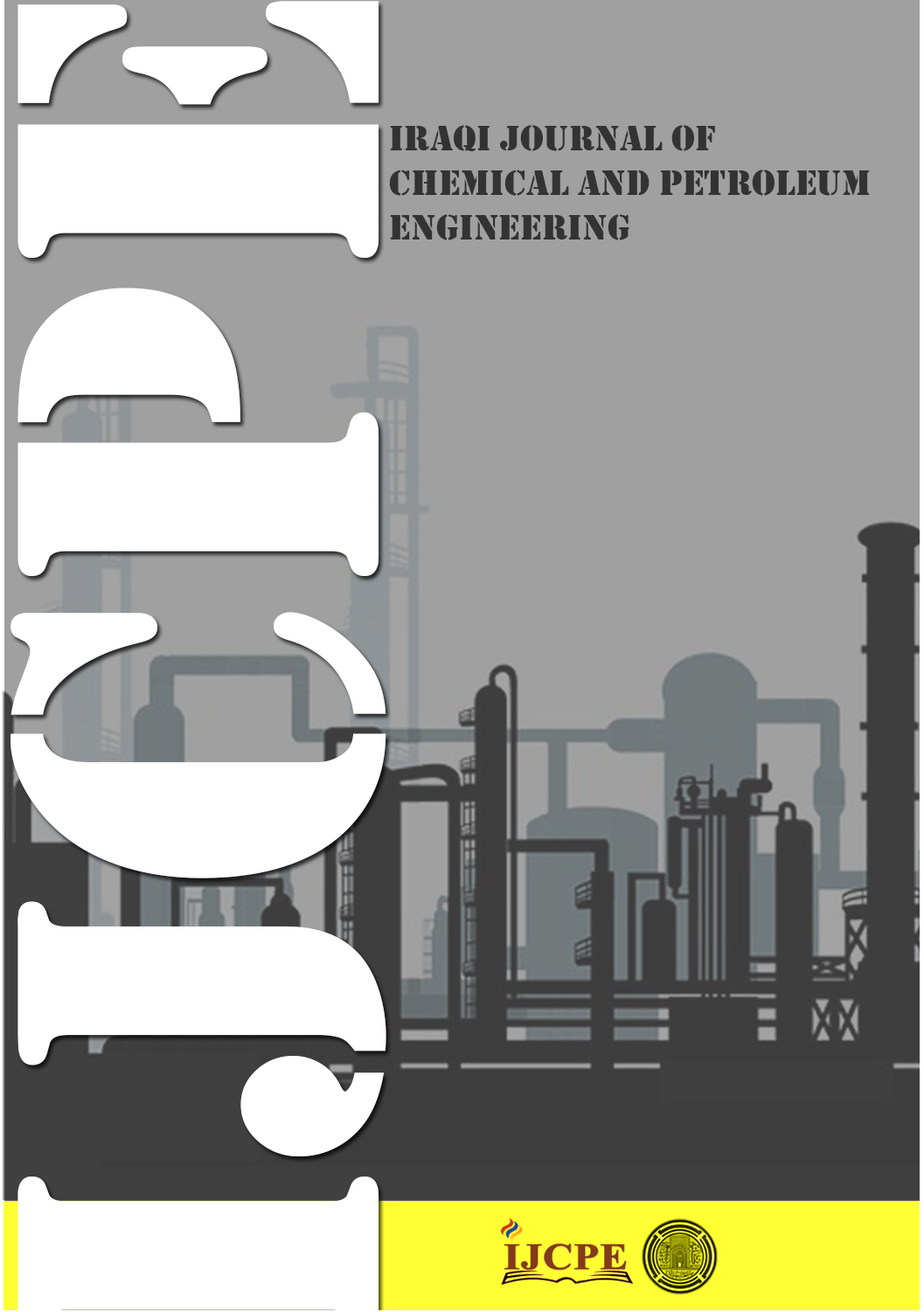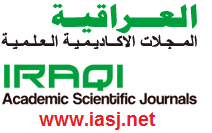Adsorption and photo degradation for organic pollutants in wastewater using copper oxide based on waste cotton impregnated with sodium hydroxide (CuO/NaOH/CW) composites
DOI:
https://doi.org/10.31699/IJCPE.2025.3.6Keywords:
cotton waste; adsorption; nanoparticles; copper oxide; water treatment; photodegradationAbstract
This work prepared new composite (CuO/NaOH/CW) and compared with another composite (HNO3/NaOH/CW) from cotton waste, sodium hydroxide, copper sulphate and nitric acid for the treatment of refinery wastewater. Dry weight analysis confirmed the attachment of 29 and 32 % NPs in the composites of copper oxide and nitric acid, and their observed slow-release behavior contributed to enhanced stability. The accessory of copper oxide to the cotton waste surface fibrils and their deep infiltration into the matrix were obviously established by characterization analysis. The composite material was evaluated for its adsorption and photodegradation capabilities for organic removal from refinery wastewater (RWW). Remarkably, the synthesized composites exhibited impressive waste cotton activities against organic pollutants, achieving reduction rates of 89.2%, 78.4%, and 55.4% for CuO/NaOH/CW, HNO3/NaOH/CW, and NaOH/CW, respectively. The cotton waste based CuO composites demonstrated non-toxicity and catalytic behavior under UV light exposure, offering insights for potential applications in organic pollutant removal and environmental remediation.
Received on 18/05/2024
Received in Revised Form on 12/09/2024
Accepted on 15/09/2024
Published on 30/09/2025
References
[1] K. M. Mousa Al-Zobai and A. A. Hassan, “Utilization of Iron Oxide Nanoparticles (Hematite) as Adsorbent for Removal of Organic Pollutants in Refinery Wastewater,” in Materials Science Forum, Trans Tech Publ, pp. 91–100, 2022, https://doi.org/10.4028/p-i14w2f
[2] M. Y. Hussein, A. N. A. Al-Naemi, and F. Y. AlJaberi, “Experimental Study of Produced Water Treatment Using Activated Carbon with Aluminum Oxide Nanoparticles, Nanofiltration, and Reverse Osmosis Membranes,” . Journal of Ecological Engineering, vol. 24, no. 5, pp. 78–87, 2023, https://doi.org/10.12911/22998993/161231
[3] G. F. Naser, I. H. Dakhil, and A. A. Hasan, “Organic pollutants removal from oilfield produced water using nano magnetite as adsorbent,” Global NEST Journal, vol. 23, no. 3, pp. 381–387, 2021, https://doi.org/10.30955/gnj.003875
[4] F. Y. AlJaberi, B. A. Abdulmajeed, A. A. Hassan, and M. L. Ghadban, “Assessment of an Electrocoagulation Reactor for the Removal of Oil Content and Turbidity from Real Oily Wastewater Using Response Surface Method,” Recent Innovations in Chemical Engineering. vol. 13, no. 1, pp. 55–71, 2020, https://doi.org/10.2174/2405520412666190830091842
[5] R. D. Nsaif, S. F. Alturki, M. S. Suwaed, and A. A. Hassan, “Lead removal from refinery wastewater by using photovoltaic electro Fenton oxidation,” in AIP Conference Proceedings, AIP Publishing, 2023, https://doi.org/10.1063/5.0163378
[6] A. A. Hassan, H. T. Naeem, and R. T. Hadi, “A Comparative Study of Chemical Material Additives on Polyacrylamide to Treatment of Waste Water in Refineries,” IOP Conference Series: Materials Science and Engineering, vol. 518, no. 6, p. 62003, 2019, https://doi.org/10.1088/1757-899X/518/6/062003
[7] A. S. Jafer, R. Al-Khateeb, B. Alobaid, A. Atiyah, and A. A. Hassan, “Copper removal from produced water by photo Fenton oxidation,” in AIP Conference Proceedings, AIP Publishing, 2023, https://doi.org/10.1063/5.0165033
[8] A. S. Atiyah, A. A. A. Al-Samawi, and A. A. Hassan, “Photovoltaic cell electro-Fenton oxidation for treatment oily wastewater,” AIP Conference Proceedings, vol. 2235, no. May, 2020, https://doi.org/10.1063/5.0008937
[9] T. H. Mhawesh and Z. T. Abd Ali, “Reuse of Brick Waste as a Cheap-Sorbent for the Removal of Nickel Ions from Aqueous Solutions,” Iraqi Journal of Chemical and Petroleum Engineering, vol. 21, no. 2, pp. 15–23, 2020, https://doi.org/10.31699/IJCPE.2020.2.3
[10] A. Saleh Jafer and A. A. Hassan, “Removal of oil content in oilfield produced water using chemically modified kiwi peels as efficient low-cost adsorbent,” Journal of Physics: Conference Series, vol. 1294, no. 7, 2019, https://doi.org/10.1088/1742-6596/1294/7/072013
[11] N. A. Raheem, N. S. Majeed, and Z. Al, “Phenol Adsorption from Simulated Wastewater Using Activated Spent Tea Leaves,”, Iraqi Journal of Chemical and Petroleum Engineering , vol. 25, no. 1, pp. 95–102, 2024, https://doi.org/10.31699/IJCPE.2024.1.9
[12] A. H. Alfattal and A. S. Abbas, “Synthesized 2nd Generation Zeolite as an Acid-Catalyst for Esterification Reaction,” Iraqi Journal of Chemical and Petroleum Engineering, vol. 20, no. 3, pp. 67–73, 2019, https://doi.org/10.31699/ijcpe.2019.3.9
[13] M. S. Jabbar and R. T. A. Alrubaye, “Metal Organic Frameworks as Gas Storage for Liquefied Petroleum Gas Vehicle in Iraq,” AIP Conference Proceedings, vol. 2660, no. 3, pp. 25–34, 2022, https://doi.org/10.1063/5.0108325
[14] M. K. Ibrahim, A. A. Al-Hassan, and A. S. Naje, “Utilisation of cassia surattensis seeds as natural adsorbent for oil content removal in oilfield produced water,” Pertanika Journal . Scencei. and Technoloy, vol. 27, no. 4, pp. 2123–2138, 2019.
[15] M. J. Ahmed, B. H. Hameed, and E. H. Hummadi, “Review on recent progress in chitosan/chitin-carbonaceous material composites for the adsorption of water pollutants,” Carbohydrate Polymers, vol. 247, no. July, 2020, https://doi.org/10.1016/j.carbpol.2020.116690
[16] T. W. Kurniawan, H. Sulistyarti, B. Rumhayati, and A. Sabarudin, “Cellulose Nanocrystals (CNCs) and Cellulose Nanofibers (CNFs) as Adsorbents of Heavy Metal Ions,” Journal of Chemistry , vol. 2023, 2023, https://doi.org/10.1155/2023/5037027
[17] M. Négrier, E. El Ahmar, R. Sescousse, M. Sauceau, and T. Budtova, “Upcycling of textile waste into high added value cellulose porous materials, aerogels and cryogels,” RSC Sustain, vol. 1, no. 2, pp. 335–345, 2023, https://doi.org/10.1039/d2su00084a
[18] A. A. Hassan and K. M. M. Al-Zobai, “Chemical oxidation for oil separation from oilfield produced water under uv irradiation using titanium dioxide as a nano-photocatalyst by batch and continuous techniques,” Inernational. Journal of Chemical Engineering, vol. 2019, 2019, https://doi.org/10.1155/2019/9810728
[19] S. M. Al-jubouri et al., “Silver oxide-zeolite for removal of an emerging contaminant by simultaneous adsorption-photocatalytic degradation under simulated sunlight irradiation,” Journal of Photochemistry & Photobiology, A: Chemistry , vol. 442, no. March, p. 114763, 2023, https://doi.org/10.1016/j.jphotochem.2023.114763
[20] R. Abdullah et al., “Fabrication of composite membrane with microcrystalline cellulose from lignocellulosic biomass as filler on cellulose acetate based membrane for water containing methylene blue treatment,” Bioresour. Technol. Reports, vol. 25, no. November 2023, p. 101728, 2024, https://doi.org/10.1016/j.biteb.2023.101728
[21] H. A. Ibrahim, A. A. Hassan, A. H. Ali, and H. M. Kareem, “Organic removal from refinery wastewater by using electro catalytic oxidation,” in AIP Conference Proceedings, AIP Publishing, 2023, https://doi.org/10.1063/5.0163257
[22] Y. Anwar, I. Ullah, M. A. Al-shaeri, and B. Oudh, “Ex-situ synthesis of bacterial cellulose-copper oxide nanoparticles for effective chemical and biological properties,”, Desalination and Water Treatment ,vol. 197, pp. 182–190, 2020, https://doi.org/10.5004/dwt.2020.25961
[23] P. Activity, “Preparation and Photocatalysis of CuO/Bentonite Based on Adsorption and Photocatalytic Activity,”, Materials (Basel), 14(19): 5803. 2021, https://doi.org/10.3390/ma14195803
[24] T. Theivasanthi, F. L. A. Christma, A. Joshua, and S. C. B. Gopinath, “International Journal of Biological Macromolecules Synthesis and characterization of cotton fiber-based nanocellulose,” International Journal of Biological Macromolecules., vol. 109, pp. 832–836, 2018, https://doi.org/10.1016/j.ijbiomac.2017.11.054
[25] U. A. Qureshi, B. H. Hameed, and M. J. Ahmed, “Adsorption of endocrine disrupting compounds and other emerging contaminants using lignocellulosic biomass-derived porous carbons: A review,” Journal of Water Process Engineering, vol. 38, no. September, p. 101380, 2020, https://doi.org/10.1016/j.jwpe.2020.101380
[26] L. H. Mahmood and M. F. Abid, “Dmetallization of Iraqi Crude oil by Using Zeolite A,” Indian Chemical Engineer, vol. 62, no. 1, pp. 92–102, 2020, https://doi.org/10.1080/00194506.2019.1641432
[27] S. M. Al-Jubouri, H. A. Sabbar, H. A. Lafta, and B. I. Waisi, “Effect of synthesis parameters on the formation 4a zeolite crystals: Characterization analysis and heavy metals uptake performance study for water treatment,” Desalination and Water Treatment., vol. 165, pp. 290–300, 2019, https://doi.org/10.5004/dwt.2019.24566
[28] S. M. Al-Jubouri, “The static aging effect on the seedless synthesis of different ranges FAU-type zeolite Y at various factors,” Iraqi Journal of Chemical and Petroleum Engineerin ., vol. 20, no. 4, pp. 7–13, 2019, https://doi.org/10.31699/IJCPE.2019.4.2
[29] M. A. Abu-dalo, S. A. Al-rosan, and B. A. Albiss, “Photocatalytic Degradation of Methylene Blue Using Polymeric Membranes Based on Cellulose Acetate Impregnated with ZnO Nanostructures,” Polymers (Basel), pp. 1–17, 2021, https://doi.org/10.3390/polym13193451
[30] S. M. Flihh and S. H. Ammar, “Fabrication and photocatalytic degradation activity of core/shell ZIF-67@CoWO4@CoS heterostructure photocatalysts under visible light,” Environmental Nanotechnology, Monitoring & Management., vol. 16, no. September, p. 100595, 2021, https://doi.org/10.1016/j.enmm.2021.100595
[31] S. B. Farise, H. A. Alabdly, and A. A. Hasan, “Lead Removal from Simulated Wastewater Using Magnetite As Adsorbent with Box-Behnken Design,” IOP Conference Series: Earth and Environmental Science, vol. 790, no. 1, 2021, https://doi.org/10.1088/1755-1315/790/1/012020
[32] P. V. Nidheesh and R. Gandhimathi, “Trends in electro-Fenton process for water and wastewater treatment: An overview,” Desalination, vol. 299, pp. 1–15, 2012, https://doi.org/10.1016/j.desal.2012.05.011
[33] H. R. D. Alamery, A. A. Hassan, and A. H. Rashid, “Copper Removal in Simulated Wastewater by Solar Fenton Oxidation,” AIP Conference Proceedings, vol. 2806, no. 1, 2023, https://doi.org/10.1063/5.0167259
[34] H. Chun, W. Yizhong, and T. Hongxiao, “Preparation and characterization of surface bond-conjugated TiO2/SiO2 and photocatalysis for azo dyes,” Applied Catalysis B: Environment and Energy., vol. 30, no. 3–4, pp. 277–285, 2001, https://doi.org/10.1016/S0926-3373(00)00237-X
[35] R. El Kaim Billah et al., “A Novel Chitosan/Nano-Hydroxyapatite Composite for the Adsorptive Removal of Cd(II) from Aqueous Solution,” Polymers (Basel), vol. 15, no. 6, 2023, https://doi.org/10.3390/polym15061524
[36] A. Fernandes, P. Makoś, Z. Wang, and G. Boczkaj, “Synergistic effect of TiO2 photocatalytic advanced oxidation processes in the treatment of refinery effluents,” Chemical Engineering Journal, vol. 391, p. 123488, 2020, https://doi.org/10.1016/j.cej.2019.123488
[37] A. S. Kasmaei, M. K. Rofouei, M. E. Olya, and S. Ahmed, “Kinetic and Thermodynamic Studies on the Reactivity of Hydroxyl Radicals in Wastewater Treatment by Advanced Oxidation Processes,” Prog. Color. Color. Coatings, vol. 13, no. 1, pp. 1–10, 2020, https://doi.org/10.30509/PCCC.2020.81596
[38] S. B. Somwanshi, S. B. Somvanshi, and P. B. Kharat, “Nanocatalyst: A brief review on synthesis to applications,” Journal of Physics: Conference r, vol. 1644, no. 1, 2020, https://doi.org/10.1088/1742-6596/1644/1/012046
Downloads
Published
Issue
Section
License
Copyright (c) 2025 The Author(s). Published by College of Engineering, University of Baghdad.

This work is licensed under a Creative Commons Attribution 4.0 International License.













